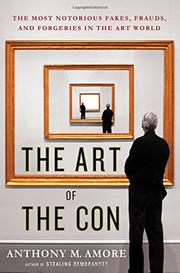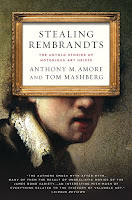Latest Activity
The Art of the Con - A Review
THE ART OF THE CON by Anthony M. Amore
* I received this ebook at no charge from Netgalley in exchange for an honest review *
“Indeed, while the art of art theft is said to be in the selling of the art, not the thievery, the art of the art scams is in the backstory, not in the picture itself.”
Mr. Amore begins his book with the story of John E. Swords’ purchase of the “Portrait of George Washington” from the artist, Gilbert Stuart. Despite living in virtual poverty Stuart was willing to sell the painting only on the condition that it never be copied or reproduced. Swords agreed – of course he did – and then immediately traveled to China where he enlisted their well-practiced copyists to make 100 reproductions of the painting. This betrayal of Gilbert Stuart was the first major “art scam” in American history. The good Captain Swords, however, was not the first to come up with idea of reproducing art for personal profit. Even Michelangelo is said to have sculpted a sleeping cupid figure and then artificially aged it in order to sell it as a lost treasure.
Why would a talented artist resort to fraud and forgery? That is the question that constantly nags at my mind when I read about these elaborate schemes and scams. The answer of course is a combination of greed and opportunity. As Mr. Amore so often points out, everyone wants to believe they have found a lost treasure or an unbelievable bargain … they want it so desperately that they are willing to short-circuit their good judgment and often their own expertise. This creates fertile ground for these forgers and con artists to ply their trade.
As the book progresses the reader learns about art fraud and forgery (and yes there is a difference) in chapters dealing with the forgeries themselves, unscrupulous art brokers, overly trusting artists and art “Ponzi schemes” through to disreputable television auctions and Internet scams.
I enjoyed Mr. Amore’s previous book “Stealing Rembrandts” very much and I was quite excited to receive this one for review; once again I was not disappointed. From the distant past of copying each artist’s brush stroke through to using today’s technology Mr. Amore touches on almost every known scenario. I use the term “touches on” quite purposely. If you are looking for an in depth biography of the forgers and a how-to, step-by-step technical explanation of how the forgeries were produced, I am sure that those books are available somewhere, but you won’t find that in this book and I don’t think that is the purpose of this book. This book gives a reader like myself – someone interested in art and curious about the forgeries, frauds, scams and cons – an easily read and understandable book with enough information to satisfy my curiosity and then (if I so choose) to use Mr. Amore’s extensive source list to delve deeper.
I always find it difficult when it comes to rating a non-fiction book. Obviously, since I picked up the book, the subject matter interests me already or I may want to begin learning more about it. If the book meets that need, and “The Art of the Con” certainly does, then it should deserve five stars. So, why did I only go with four in this case? Two reasons; firstly, although overall it was a book I enjoyed reading, occasionally Mr. Amore’s conversational style of writing slipped into a bit of a “text book” mode that felt a little dry. Secondly, (and this is a purely personal preference so excuse me if I sound like a whiny toddler), I wish that the book had included pictures. This subject is very visual and I often found myself going online to look up the works of art I was reading about – unfortunately, I do not always read in close proximity to a computer.
Anthony M. Amore is the head of security and chief investigator at the Isabella Stewart Gardner Museum in Boston. He has been described in the book "Art & Crime" as "among the most innovative, and most effective, museum security directors in the world." He also heads the museum's own investigation into the infamous theft of 13 priceless works for art from the Gardner-- the largest property theft in world history.
Prior to joining the Gardner Museum, Anthony was an assistant director with the Transportation Security Administration where he helped to rebuild security at Logan Airport after the tragic events of 9/11. He is also a former special agent with the Federal Aviation Administration, where he was the lead agent responding to the Richard Reid "shoebomber" attack.
His first book, "Stealing Rembrandts," was a Wall Street Journal True Crime Best Seller.
© 2024 Created by Jen Rattie.
Powered by
![]()



You need to be a member of Literary Addicts to add comments!
Join Literary Addicts